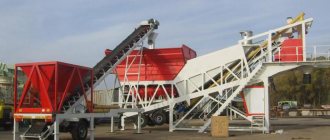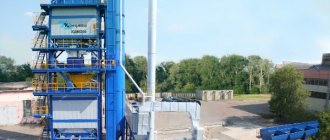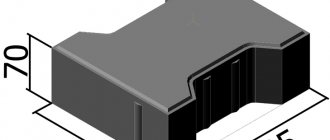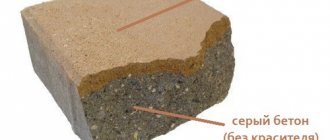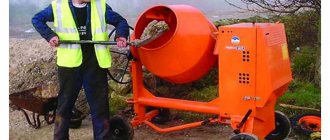To store dry concrete mixtures or other bulk materials, specially designed and prepared equipment is required - silos.
To store dry concrete mixtures or other bulk materials, specially designed and prepared equipment is required - silos. They are closed, capacious bins with receiving and distributing devices, as well as auxiliary equipment and mechanisms. The container for storing bulk products is made in the form of a tall metal cylinder, closed on top with a lid and having ventilation and filters.
The lower part has a cone-shaped structure with a closing valve - gate. Through it, the required portions of cement or other mixture are dispensed. The entire structure is mounted vertically on supports. Today, convenient, spacious cement silos have become an integral part of warehouses for bulk building materials and are used by many companies.
Construction of a silo for cement
The main element of a cement silo is a cylindrical container (hopper) mounted on a welded base frame. When installing, the frame supports are attached to the concrete base with anchor bolts.
The tightness of the container from above is ensured by a flat or rounded “lid”, and the “bottom” has a cone shape convenient for unloading cement. At the bottom of the cone, a locking device is installed - a slide valve or disk valve.
Loading and unloading is carried out as follows:
- the flexible loading pipe of the cement tanker is connected to a rigidly fixed pipe (cement pipeline) of the silo (located on the side, along the bunker - in the figure above). Then, with the help of compressors, the cement is “pushed” from the cement truck into the container. After filling the bunker, the compressor is turned off;
- open the shutter at the bottom of the silo - the cement, under the influence of the aeration system (installed outside the cone) or its own weight, moves to the outlet. Then two options are possible - a screw conveyor (in the figure above) or bulk loading directly into a wagon or cement truck.
The second is possible if the bottom of the bunker is raised above the ground and a platform is equipped for access of special vehicles to the area under the silo cone.
The top “lid” of the bunker is equipped with:
- filter - to eliminate cement dust from the air inside the silo and prevent the release of dust into the atmosphere during loading. As the container is filled, “excess” air is forced out of it. The filter sucks in dust particles, releasing a clean air stream. Periodically, industrial vibrators shake the filter system - the collected dust is returned to the silo, and the filter is cleaned;
- safety (emergency, relief) valve - to protect the container from pressure surges during loading or unloading. The valve prevents damage to the container itself and the filter;
- hatch for access to the internal staircase of the silo;
- platform for service personnel with fencing.
The opening of the cement pipeline (through which the binder is loaded into the silo) can be located in the top cover or side surface of the cylinder - shown in the figure.
To access the upper platform, a second, external staircase with a protective fence is provided - it is not included in the basic package, and in some cases it is removed.
Types of soldering irons
When filling and unloading, the cement level in the tank is monitored using sensors. Several level switches can be installed along the silo cylinder, but are usually limited to two sensors:
- minimum – during unloading, it informs you that an extremely small amount of cement has been reached. The sensor is installed just above the junction of the conical bottom and the cylinder;
- maximum – prevents the container from overflowing when loading binder. The device is mounted just below the cover.
The silo in the figure is equipped with two sensors – minimum and maximum. They are discrete and do not provide information about “intermediate” volumes of cement. For this purpose, an additional radar sensor is provided, which allows you to monitor the volume of contents continuously, in a non-contact manner.
Discrete level sensors differ in their operating principle and design. The silo can be equipped with sensors:
- rotational (flag);
- inclined type;
- vibration;
- capacitive.
The widespread use of rotary level sensors is due to:
- reliability of the design;
- relatively low price;
- efficiency when working in highly dusty conditions;
- durability and ease of maintenance.
The rotary sensor includes:
- low power electric motor - usually up to 4 or 2.5 W. Distinctive features of the rotor are an elongated shaft and the possibility of cantilever mounting on the vertical wall of a silo;
- a blade mounted on the end of the motor shaft - it can be shaped like a flag or a rectangle. The blade is attached to the shaft using a cotter pin - this connection does not loosen under the influence of vibrations and makes it easy to change the blade if it breaks;
- an automatic control system mounted on the control panel and a device that provides a sound signal when the sensor is triggered.
Production of silos and bunkers
Steel silos and bunkers are used as universal storage in agriculture, construction and food industries, in production for the reception, storage and delivery of bulk substances, for example, sand, cement, gypsum, lime, grain, flour and other fine granular material. They can be installed either separately or as a single complex of silo buildings.
The bunkers are distinguished by the possibility of dosed unloading and loading of the product, its complete protection from external factors, moisture resistance, etc. Depending on the volume, they are delivered to the construction site assembled, which reduces transportation and installation costs.
The Saratov Reservoir Plant manufactures silos from galvanized, carbon, stainless and black steel , depending on the material being stored: galvanized steel for cement, stainless steel for food products, black steel for sand.
To impart corrosion resistance, rolled metal is processed by hot-dip galvanizing (according to GOST 52246-2004 “Hot-dip galvanized rolled sheets. Technical conditions”).
Metal structures can be manufactured in two ways: the sheet-by-sheet assembly method and the rolling method, depending on the volume. All elements are made from steel sheets with a thickness of 0.8-12 mm, depending on capacity and diameter. Steel sheets are connected by welding or bolts. The method of fastening the elements must ensure maximum tightness of the entire metal structure.
The SARRZⓇ plant produces silos with volumes from 5 m3 to 1000 m3 .
Silos up to 50 m3 are manufactured using the sheet-by-sheet assembly method, i.e. they have dimensions ready for transportation. Silos larger than 50 m3 are a prefabricated structure or manufactured by rolling. In the latter case, the wall is produced in a factory, then rolled up and delivered to the installation site.
The manufacturing method and design are selected based on the design characteristics, load-bearing capacity and the wishes of the Customer. The perceived loads from its own weight, the mass of stored material, wind and snow loads, and seismic operating conditions are taken into account. To maintain vertical stability, silos and bunkers are equipped with stiffeners made of corrugated sheets (in accordance with the “Recommendations for strengthening and repairing building structures of engineering structures”).
The design, manufacture and installation of silos is regulated by:
- SNiP 2.09.03-85 “Structures of industrial enterprises”
- SNiP 2.10.05-85 “Enterprises, buildings and structures for grain storage and processing”
- GOST 25627-83 “Reinforced concrete products for silo structures of elevators and grain processing enterprises. General technical conditions"
Operating principle of a rotary sensor
When loading cement, the following occurs:
- Turning on the electric motor - the shaft with the blade begins to rotate at low speed. Torque from the shaft is transmitted to the sensor shaft.
- Filling the container to the sensor level - the blade enters the cement mass. Since the engine power is low, the “flag” gets stuck in the cement and stops rotating.
- Closing the switch in the sensor control system with a signal sent to the control panel and an audible warning. In this case, the engine automatically turns off.
When unloading, the process occurs in reverse order:
- The blade is released from the cement.
- The spring is activated, opening the switches.
- Power is supplied to the motor, and a signal is sent to the control panel that the level of the contents of the container has decreased.
How long does it take for concrete to gain strength?
Even completely dry cement tends to quickly stick to the walls of the container and cake. This has a bad effect on the properties of the material and interferes with unloading - after 1–2 days the binder “refuses” to move to the outlet when the shutter is opened. The problem is solved by including vibration shaking systems (vibrating pan or industrial vibrators) or aeration into the package.
Vibrators contribute to the gradual destruction of the silo; the vibrating pan and aeration systems do not have this drawback. Due to the low price, preference is usually given to an aeration system.
Silo equipment
Each silo in its kit contains the following elements:
- Silo can. Directly the tank itself for loading cement.
- The supports on which the structure will stand.
- Silo ladder. Needed for lifting up to check the loading level of the silo.
- Fencing on the silo roof. Serves to prevent accidents at work.
At the customer's request, the following parts can be included in the silo kit:
- Silage filter.
- Sensors that monitor the level of cement loading.
- Cement aeration system.
- Emergency pressure relief valve. For emergency use to avoid tank rupture or breakage.
The price of silo will be calculated individually, based on its configuration, volume and weight.
Cement silo aeration system
The aeration system includes:
- compressor unit providing compressed air supply;
- distribution pipe through which air reaches the jets or aeration plates. The flexible hose is attached to the hopper using brackets, encircling the discharge cone of the container;
- a filter that cleans and regulates the flow entering the pipeline from the compressor;
- aeration plates or jets through which compressed air enters the cone. 6–10 jets are screwed to fittings welded into the conical wall and connected to the distribution pipeline;
Plates, unlike jets, are installed from the inside of the cone, so mounting the plates on an existing silo is impossible. To repair or clean the plates, access to the inside of the container is also necessary.
- an electromagnetic valve, the opening of which allows air from the compressor line to pass through the filter into the pipeline;
- automatic control system for the cement blowing process.
When the aeration system is turned on, compressed air from the compressor enters the main line, then through the pipeline, into the jets or to the plates. The air flow blows through the cement, removing “caking zones” and simplifying unloading.
Types of silos
Models may have fundamental design differences or configuration features. However, 3 large groups can be distinguished:
Stationary solid containers
We are talking about steel bunkers, which are delivered to the installation site without disassembling the body. Such containers are distinguished by increased reliability and durability - they do not have fastenings that can be damaged. Disadvantage – limited volume – 75–100 tons. Larger containers are technically impossible to transport;
The first silos for storing cement were stationary and made of reinforced concrete. Today they can be seen in some old factories.
Collapsible (panel) – modular bunkers
Consisting of a cone and individual “can” elements. Such containers have a wide range of capacities, are easy to transport, and can be assembled and disassembled several times.
Mobile
Small (but not cheap) silos with a horizontally located container. They can be laid on a chassis and transported like a trailer. When delivered to the site, you only need to extend and secure the supports.
Container silos are a type of mobile silos. Their difference from silo trailers is their larger volume; such containers can be transported by trains or cargo water transport.
When choosing a warehouse, first of all, pay attention to the maximum permissible capacity. It is chosen so that all contents are used within 7 days. Cement that has been in use longer cannot be considered to meet the brand specifications.
Classification and table of concrete density
Modern production facilities produce cement silos with a volume ranging from several to several hundred cubic meters (with a capacity of up to hundreds of tons, respectively). Among the running capacities:
- 6–35 tons. Suitable for small production volumes per day, production of special cements with additives. Such containers are installed by factories producing paving slabs and building mixtures, and by companies involved in packaging binders. A small “can” can simply be installed indoors without building a foundation;
- 45–70 t. A universal option that can be used in a small concrete plant or during the manufacturing process or packaging of dry mixes;
- 80–200 tons. They assume a large daily yield and consumption of cement. Such containers are in demand in large concrete plants and warehouses.
Why do you need a cement silo?
A cement silo is a cylindrical metal structure that allows cement or other construction product to be stored in proper form and moved if necessary. The metal cement silo is manufactured taking into account all technical requirements. Welding of the container occurs in a carbon dioxide environment using semi-automatic welding equipment, which makes it possible to produce a structure with a high level of precision and accuracy. The supporting frame, container and other parts of silos are made of high-quality steel with a thickness of 4-6 mm and are coated with paint and a protective primer against corrosion. This makes it possible to work in absolutely any climatic conditions and guarantees long-term operation of the products. Regarding the manufacture of the case, 2 options are allowed:
- all-welded - for products with a capacity of up to 75 tons of cement;
- collapsible - for buildings with a capacity of over 75 tons.
The implementation of cement silos requires increased requirements for the level of quality of all welding and assembly work carried out, since leakage of any weld can subsequently lead to capillary hydration of cement inside the structure. Cement silos have the following standard equipment:
- container for bulk materials;
- supporting structures;
- ladder;
- service area;
- fencing;
- loading pipe.
The proper functioning of the cement container requires its vertical location. The installation of a 100-ton tower with a height of 15 meters and a diameter of over 4 meters, which is a typical silo design, is designed with the expectation of long-term operation of the structure in one place. Conventionally, the tower version is also called “stationary”; an alternative to it is a mobile cement silo. These variations resemble the shape of a cargo truck, a kind of container on wheels that combines the speed of deployment on a construction site and the reliability of stationary equipment.
Cement silo installation
Usually silage is collected “on site”, the general algorithm is as follows:
- Preparation of the foundation - the dimensions of the foundation are calculated for the cement silo of the selected model, taking into account the type and characteristics of the soil;
- Installation of the container support - fastening and leveling is carried out using anchor bolts.
- Assembling a cement silo according to the drawing - start with a cone and end with sensors
- Check the position and final tightening of the bolts, if necessary, fill the foundation.
When planning the installation of a bunker, it is necessary to provide a platform for vehicle access - at least 50 m of free space along the perimeter of the base.
Compliance with the operating rules will help prevent damage to the container; first of all, the following is unacceptable:
- allow overloading by more than 1% of the silo capacity according to the technical data sheet;
- load bulk material after the maximum sensor signal;
- allow filling with cement containing hard or metal particles.
It is necessary to maintain the cleanliness of the warehouse and stop operating the installation if:
- malfunctions of mechanical or electromagnetic components;
- violations of the tightness of threaded or welded connections;
- damage to cement or air ducts and other parts.
Production of silos
The manufacture of cement silos is carried out according to the drawing. They are available in various sizes and, accordingly, weights. The most common materials for making silos are concrete and metal. This tank itself is made in the shape of a cylinder with parts made of strong sheet steel. To make it easy to load cement into such a container, a pipe is provided. After the silo has been brought to the site, it is installed strictly vertically. In order for the structure to meet all safety requirements, it is placed on special metal supports in the form of pipes. The bottom of the tank is specially made in the shape of a cone, at the end of which a shutter is installed. This device is used to receive or dispense cement. The shutter can optionally be made of one of two types:
- Gate
- Turning.
To prevent cement from stagnating in the silo, a pneumatic pump is used. If several silos are installed, it will be called a cement warehouse. Cement silos are produced in total volumes from 30 to 120 tons.


